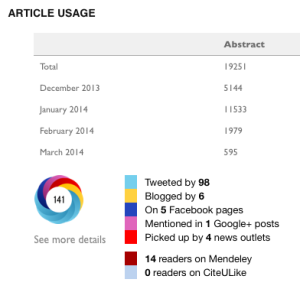
Arxiv and BioRxiv Fans - Please Help
I have been facing hard time in trying to convince a group of biologist collaborators to submit a joint paper to Arxiv/BioRxiv, while the paper is in review/revision/review/revision and endless other loops. The comments I received from them are the same old ones, and I am surprised I need to defend them in 2014.
Criticism 1 - “We will get scooped.”
To defend that, I had to cite long example of the opposite happening in physics. That got me to -
Criticism 2 - “We biologists do things differently from physicists.”
To address that, I showed a large number of excellent bioinformatics papers in arxiv, and that got me to -
Criticism 3 - “I casually checked bioRxiv and did not find many well-known biologists submit papers there. It is a possibly a repository for bad and unfinished papers.”
To address that, I googled and found this old and excellent post written by Nick Loman. It covers arxiv, because bioRxiv is only a few months old.
Question for you - is there an updated list? Can we compile a larger and more up-to-date list of top quality biology preprints being submitted to arxiv and bioRxiv? If you submit examples in the comment section, I will prepare a wiki page that others can use to convince their biologist colleagues.
Thanks !!
All the cool kids are on arXiv and Haldanes Sieve .. why you should be too
Posted 15th October 2012: Species Identification and Unbiased Profiling of Complex Microbial Communities Using Shotgun Illumina Sequencing of 16S rRNA Amplicon Sequences (Haldanes Sieve, arXiv). This paper describes a novel method of using shotgun sequencing of long 16S amplicons to permit species- level assignments.
Posted 28th September 2012: Horizontal gene transfer may explain variation in ?s (Haldanes Sieve) a paper from Lenski no less, which gives a possible explanation of the intriguing findings of potential mutational hotspots in the E. coli genome published in Nature by Inigo Martincorena and Nicholas Luscombe. This paper suggested an evolutionary risk management strategy which challenges our fundamental understanding of genetic mutations being acquired randomly and subsequently selected for (demonstrated beautifully by Luria and Delbruck in 1943). Lenski, using data from his long-term E. coli evolution experiment suggests that in fact undetected recombination is instead the likely cause for these mutational hotspots.
Posted 13 Oct 2012: A 454 survey of the community composition and core microbiome of the common bed bug, Cimex lectularius, reveals significant microbial community structure across an urban landscape (http://arxiv.org/abs/1210.3707). Notable for being one of the first microbial ecology studies published in arXiv and obviously bed-bugs are kind of cool/gross .
Posted 19 Sep 2012: Maximum Likelihood Estimation of Frequencies of Known Haplotypes from Pooled Sequence Data (Haldanes Sieve)- a really interesting bit of software which may be useful for haplotype reconstruction in metagenomics and pooled sequencing experiments. I plan to give this a whirl and feedback to the authors my findings.
Posted 1 Oct 2012: Best Practices for Scientific Computing (Haldanes Sieve) not specifically microbial or biological but a useful treatise on how to write better code which would be useful for those writing bioinformatics software and pipelines, or even just doing analysis.
Update:
Casey Bergman shared another excellent blog post on arxiv. His post covers the citation aspect and discusses how posting in arxiv will increase the citations through google scholar. Assemblathon paper is a good example.
Accelerating Your Science with arXiv and Google Scholar
arXiv preprints are rapidly indexed by Google Scholar (with 1-2 days in my experience) and thus can be discovered easily by others using a standard Google Scholar search.
arXiv preprints are listed in your Google Scholar profile, so when people browse your profile for your most recent papers they will find arXiv preprints at the top of the list (e.g. see Graham Coops Google Scholar profile here).
Citations to your arXiv preprints are automatically updated in your Google Scholar profile, allowing you to see who is citing your most recent work.
References included in your arXiv preprints will be indexed by Google Scholar and linked to citations in other peoples Google Scholar profiles, allowing them to find your arXiv preprint via citations to their work.
Inclusion of an arXiv preprint in your Google Scholar profile allows Google Scholar Updates to provide better recommendations for what you should read, which is particularly important when you are moving into a new area of research that you have not previously published on.
[Update June 14, 2013] Once Google Scholar has indexed your preprint on arXiv it will automatically generate a set of Related Articles, which you can browse to identify previously published work related to your manuscript. This is especially useful at the preprint stage, since you can incorporate related articles you may have missed before submission or during revision.
-—————————————-
Richard Sever sent these two helpful tweet -
1. 
His link cites “Ancient human genomes suggest three ancestral populations for present-day Europeans”

2. Second tweet showed a nice paper by Leonid Kruglyak that appeared in bioRxiv before in Natur e.
Genetics of single-cell protein abundance variation in large yeast populations